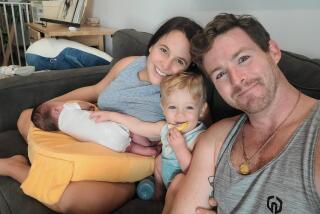The birth of a trend: Posting childbirth videos online
- Share via
Google “childbirth video,” and hundreds of videos pop up, some with millions of views. “The Unassisted Birth of Jason Shawn II,” a YouTube video which shows a woman grunting and shrieking in an inflatable pool before giving birth on her own, has 3.5 million views, with a lot of opinionated strangers weighing in on this intensely personal moment.
Some videos are so graphic you want to turn away, and so vivid that it can trigger memories women might rather forget.
Nonetheless, documenting every minute has become a form of 21st century scrapbooking. In the Age of Social Media, if an event is not photographed, filmed, Facebooked, YouTubed, tweeted or tumblr’d, did it happen? Birth videos, though, have got to be the final frontier.
Women say they want video to promote a certain kind of birth, to reclaim their power, and to remember a baby’s first moments. Some want documentation because they want to return later to savor the small, exquisite details they missed in their hormonal haze. Filming is easier and more portable than ever before. Once you needed a crew. Now you need a phone. And perhaps, in an increasingly isolated world, filming births is a way to stay connected during one of life’s most intimate moments, to build community, to teach, and to recreate the ancient birth hut virtually.
“You are seeing a lot more births on YouTube,” said Andrea Filardi, a certified childbirth educator and doula who works in Los Angeles. “A lot of people want to show that birth is a natural process. With Facebook and multimedia, they can say, ‘Look at the way my kid was born.’ I have been in a room where the husband’s mother wanted to be at the birth, but she was dying of brain cancer, so they Skyped the birth.”
“You can argue that we are oversharing,” said Robert Hernandez, a web journalism professor at USC. “But technology did not force us to do this, it just facilitated it.”
Life is being shared in real time, he said. “People share photos of shootings, strokes, car accidents. It is in our social fabric. It is not a rarity anymore.”
Jodie Myers has been filming births for 12 years in Los Angeles. “People want this,” she said. “This is the most sacred moment in their lives. They want to capture it.”
Myers takes pride in creating films with a cinematic look that help clients remember more than the trauma of the moment. She tastefully edits out the slower sections, like endless pushing, or a 36-hour monotonous labor. “Some of the births on YouTube are kind of boring,” she said. “They are not done artistically.”
Photographer Alice Shippee wanted to video the birth of her third child, and a Google search led her to Myers. “With each kid, times go by a little more quickly. We videotape and photograph all the most important events in life — graduations and weddings, engagement parties and the first day of school. It will be such a gift to my kid to be able to see the first day of his life. To see what our family was like in that moment that he came into the world.”
More than 20 people crowded into the Palos Verdes Estates bedroom where they had inflated a pool. But Shippee said she did not get performance anxiety.
“I was geared up for it to be a big tribal event. I knew that when I go to that place that you have to go to get your baby out, it wouldn’t have mattered if the pizza man walked in.”
Since their son, Zen, was born 19 months ago, the Shippees have not posted their birth video on YouTube, or shared it on Facebook. Alice Shippee, a former teacher who is Facebook friends with 500 of her former students, said, “I didn’t want to become a spectacle on the web.”
But they have shared the video with friends, and have watched it as a family “surprisingly often,” Shippee said — more than their wedding video.
Obstetrician Susan Morrison, who delivers babies at Cedars-Sinai Medical Center, chose to have the births of both of her children, who were born by C-section, shot on video. In her case, by another doctor. “I wanted to see my birth,” she said. “You do feel disconnected from the process with a C-section.”
Filardi, the doula, said she understands the desire to film.
“In media, in TV, they show birth with women all hysterical, and screaming, and the baby is falling out. It can be quiet and peaceful and a totally different thing. Sometimes when these videos come up on-line, women can see birth does not have to be such a scary, out-of-control thing.”






